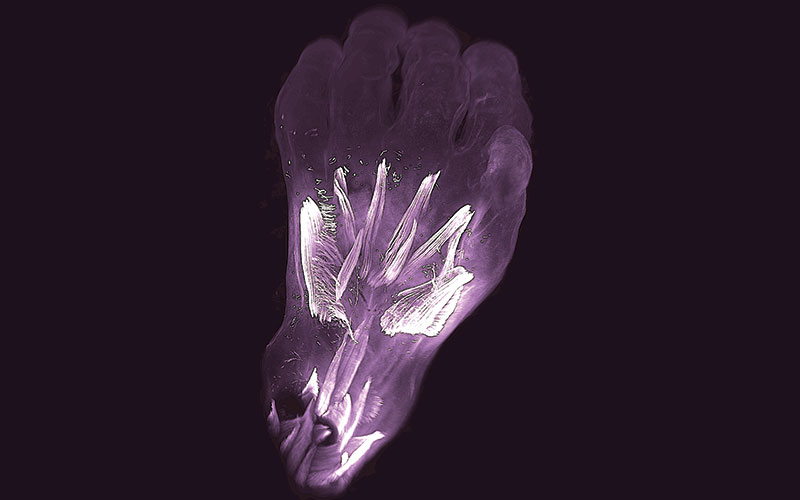Biologist Dr Rui Diogo discusses the discovery of embryonic hand muscles and their evolutionary implications.

When the amphibians first crawled out of the water and ventured onto land over 300 million years ago, they began the evolutionary process that saw them branch off into two distinct classes of animals: the reptiles and the mammals. The first small mammals appeared around 225 million years ago, the first apes around 60 million years ago, the first humans at about six million years ago, and the first members of our species, Homo sapiens, about 300,000 years ago. Given all that time, you would be forgiven for thinking that every trace of the amphibian (and the reptilian) might have been expunged from our biology, but a study of human embryos has found that we retain a few unexpected vestiges of that common ancestry.
The research, headed by Dr Rui Diogo at the Howard University in Washington DC, looked at images of the hands of embryos from seven to 10 weeks old and fetuses from 10 to 13 weeks old and discovered what appear to be the traces of muscles. However, these muscles don’t hang around for long. They tend to disappear, and most babies are born without them, though they may persist in birth defects and may be the cause of certain deformities.
The images of the 15 embryos were taken by a team of French scientists, using a technique that attaches modified antibodies to body matter, in this case the myosin that forms the muscles. But while the French team were mainly concentrating on producing detailed images, it took the trained eyes of Diogo to realise the evolutionary and medical significance. “When I saw their images I began to see strange things,” he says. “Things that I know are in non-human adult animals that should not be present in humans. I asked them for the full images and I saw one by one, at seven, eight, nine weeks and so on – clearly there were a lot of these atavistic muscles.”
Diogo believes the findings can tell us a lot about evolution and why certain parts of our biology persist even though they serve no practical use. “If everything had a purpose, we would not have the appendix or these muscles. They are not doing any harm and clearly we can survive with them.”
At the heart of this, he argues, is whether evolution produces results that are optimal or simply good enough.
“I think it is probably not easy for evolution to just remove stuff. A lot of animals have this repetition of muscles going to each of the five digits, and each muscle will have three or four smaller muscles just to control extension and contraction. What happened in human evolution is that our thumb is very mobile, with a lot of muscles, and those remain. But the other digits lost many of these small muscles and so lost a lot
of precise movement. We think that it is probably very difficult for the growing embryo to say we need just one of the five muscles going to each digit, so probably we have to form layers that go to all the digits, then as the layers begin to build up we lose those parts of the layer that go to the digits that we don’t need to move in such a precise way. I think this is an example of ‘good enough’ evolution.”
Another issue the muscles pose is the notion of ‘progress’. “We can call them vestigial muscles because they are doing nothing in the embryo, they don’t have a purpose. But ‘atavistic’ should be applied because it emphasises that these traits were lost in evolution, whereas vestigial structures like the appendix were never lost in our adult ancestors. Take for instance the tail. We lost it 20 million years ago during the transitions from monkeys to apes, which have no tail. No adult mammal has the muscles we see in the picture, meaning that they were lost more than 250 million years ago. So these muscles are a powerful illustration of atavisms that were lost a long time ago, but remain in prenatal development.”
The reason we lose certain traits and features as adults, says Diogo, is because they are not useful. “Each animal will adapt to its local conditions. So when fish go to a cave, the cave is dark and they cannot see anything, they lose the eyes during evolution. During the evolutionary stages to humans, it became less and less useful to use the other four digits so precisely. That is not better or worse, just good enough.
“Most people think that humans are more complex, but what this clearly shows is that even during our normal development we lose structures. A human embryo has more structures than a human adult. We have around 30 muscles in the hands and feet at only seven weeks and around 20 when we are adults. Our evolution is mainly an evolution of simplification. In total, a human adult has fewer muscles and bones than an adult mouse or an adult salamander.”
Diogo is now hoping that the French team will produce images of different parts of the embryos. “I would like to look at the head because I know we have some atavistic muscles there as well, based on preliminary observations. One of them is a facial expression muscle, but we have also lost this during evolution and I really want to look at it in detail.”
Dr Rui Diogo is Associate Professor at the Howard University College of Medicine
